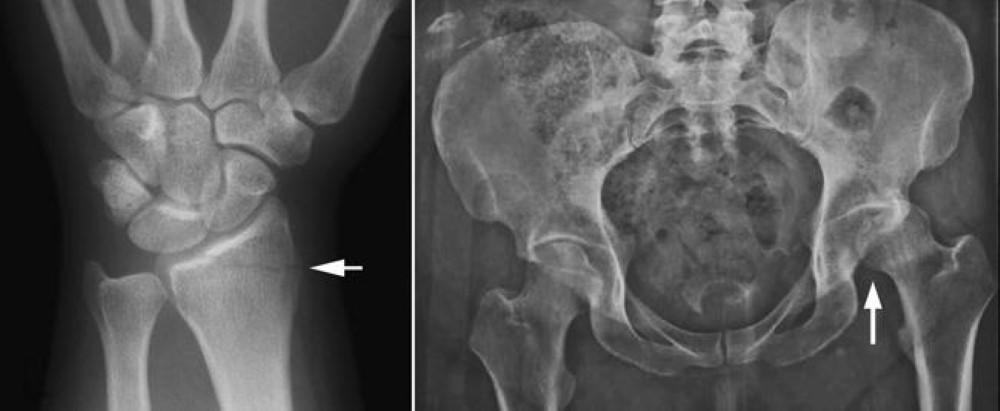Treatment
Pregnancy and X-rays
To help diagnose and treat musculoskeletal injuries, orthopaedic surgeons often recommend X-rays. If you experience an injury while you are pregnant, you may be concerned about the impact that radiation from an X-ray will have on your unborn child.
Fortunately, the potential for harm to your baby is generally quite low. It has been shown that the amount of radiation received from a single diagnostic X-ray is so small that it is unlikely to pose a risk to a developing baby.
The Role of X-ray Imaging
X-rays are the most common and widely available diagnostic imaging technique. They can provide your doctor with important and potentially life-saving information about many medical conditions and are often used to detect bone fractures and dislocated joints after falls and accidents.
During an X-ray, the technician positions the part of your body being X-rayed between the X-ray machine and photographic film. You will then be asked to hold still while the machine briefly sends electromagnetic waves (radiation) through your body, exposing the film to reflect your internal structure.
Whenever possible, if you are pregnant, your doctor will consider using imaging studies that do not emit X-ray radiation to diagnose your injury or condition — such as magnetic resonance imaging (MRI) scans and ultrasound. These imaging studies are not always practical or available, however, and may not offer your doctor the same information that can be routinely obtained with an X-ray.
Magnetic Resonance Imaging (MRI) Scan
MRI is a type of imaging that your doctor may recommend to evaluate soft tissues like tendons, ligaments, or cartilage. Because it does not use radiation (like X-rays or CT scans do), it has been considered safe during pregnancy.
A 2016 study published in the Journal of the American Medical Association (JAMA) demonstrated that MRI during the first trimester of pregnancy was not associated with increased harm to the fetus or to early childhood development.
However, sometimes a contrast called gadolinium is used in an MRI to improve the visibility of certain structures. Having a gadolinium MRI at any time during pregnancy was associated with increased risk of inflammatory conditions, skin conditions, and possibly stillbirth. So, while an MRI without gadolinium is safe, gadolinium MRIs should be avoided during pregnancy unless absolutely necessary to significantly improve the ability of the MRI to evaluate the issue.
Ultrasound
Ultrasound (US) uses ultrasonic waves to evaluate deep anatomic structures. It does not emit any radiation or use a high-powered magnet.
During an ultrasound, a probe called a transducer is placed on the skin overlying the area of interest, enabling the ultrasonographer to see images of what lies in the deeper layers of tissue.
Commonly used during pregnancy to evaluate the health of the pregnancy, ultrasound is also often used to help diagnose conditions in pregnant patients, such as:
- Tendinitis
- Bursitis
- Carpal tunnel syndrome
- Rotator cuff tears
- Joint problems
- Tumors and cysts
Because it doesn’t involve radiation or a magnet, ultrasound is also commonly used in children and patients with pacemakers.
Per the recommendations of the American College of Obstetricians and Gynecologists' Committee on Obstetric Practice, musculoskeletal ultrasound is not associated with risk to the pregnancy and may be used when needed to assist with diagnosis in pregnant patients.
Computed Tomography (CT) Scan
A computed tomography (CT) scan, uses radiation to view bones and soft tissues. Due to its use of radiation, and at times IV contrast, the benefits and risks of CT should be weighed strongly during pregnancy.
CT Scans performed on areas farther away from the abdomen (i.e., the chest, arms, or legs) are less likely to cause dangerous exposure. However, given the concern about radiation exposure with CT, the evaluation of muscles and bones in the arms or legs is more ideally achieved with MRI or ultrasound.
When CT is needed to evaluate the bones of the pelvis or surrounding area, the amount of radiation can be reduced; the low-exposure technique can minimize the risk to the fetus while still providing adequate visualization to make the diagnosis.
Per the recommendations of the American College of Obstetricians and Gynecologists' Committee on Obstetric Practice, when CT scan is necessary for diagnosis, it should not be withheld from a pregnant patient.
How Much X-ray Radiation Is Considered Safe
The amount of X-ray radiation absorbed by the body is measured in rad or its fraction, millirad. One rad is equal to 1000 millirad.
Studies show that exposing an unborn baby to more than 10 rad increases the risk of birth defects, learning disabilities, eye problems, and childhood cancers. Most routine musculoskeletal X-rays — particularly those that are not directed to the abdomen or torso — are much weaker than this and expose the developing baby to only a small fraction of a rad.
For example, the approximate amount of radiation that an unborn baby receives from the more commonly ordered diagnostic X-rays includes:
- Less than 1 millirad for an X-ray of the upper or lower extremities (arms or legs)
- Less than 100 millirad for an X-ray of the chest
- 40 to 240 millirad for an X-ray of the pelvis
- 200 to 245 millirad for an X-ray of the abdomen
- 51 to 370 millirad for X-rays of the hip and femur (thighbone)
Reducing Your Risks
Although there is very little risk from a single diagnostic X-ray, steps should always be taken to help minimize a developing baby's exposure to radiation. Following the guidelines below will help protect your unborn child.
Take Precautions
- Always wear a lead apron if it will not interfere with the body region that is being X-rayed. Even if you are not pregnant, wearing a lead apron will help protect you from the risk of genetic damage to your reproductive organs.
- Do not hold a child or pet that is being X-rayed. If you must do so, wear a lead apron.
- If you are around radiation at work, wear a film badge to monitor the amount of exposure you receive. If needed, the badge can be analyzed to ensure that you and your baby are safe.
- Talk to your employer about ways to reduce or eliminate radiation exposure at work — such as shielding yourself from the source of the radiation.
Work With Your Doctor
- If you are pregnant, or think you might be pregnant, tell your doctor before having an X-ray, especially if it is of your abdomen or torso.
- If you have recently had a similar X-ray, mention it to your doctor. It may not be necessary to repeat the X-ray.
- If you discover that you are pregnant after having an X-ray, notify your doctor. Be reassured, however, that it is highly unlikely that a single X-ray will affect your unborn baby. This is particularly true if the X-ray was confined to a part of your body away from your abdomen or torso.
- If you are receiving radiation therapy, talk with your doctor about the amount of radiation you are receiving and the extent to which your baby is exposed. You may wish to consult with a medical physicist in planning the type and schedule of radiation therapy.
Share Your Concerns
Do not hesitate to discuss your concerns about X-ray radiation with your doctor. Depending on your medical condition or injury, it may be acceptable to postpone an X-ray until after your child is born.
Keep in mind, however, that the benefit of having the prescribed X-ray will likely outweigh any potential risk to your baby. In fact, in some cases, it might be more harmful to not have the X-ray. If your X-ray cannot be postponed, remember that any potential risk to your child is very remote.
Contributed and/or Updated by
Peer-Reviewed by
AAOS does not endorse any treatments, procedures, products, or physicians referenced herein. This information is provided as an educational service and is not intended to serve as medical advice. Anyone seeking specific orthopaedic advice or assistance should consult his or her orthopaedic surgeon, or locate one in your area through the AAOS Find an Orthopaedist program on this website.








